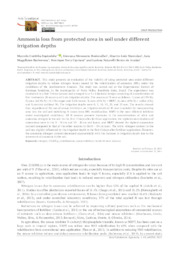Ammonia loss from protected urea in soil under different irrigation depths.
Ammonia loss from protected urea in soil under different irrigation depths.
Author(s): ESPINDULA, M. C.; RODOVALHO, G. M.; MARCOLAN, A. L.; BARBERENA, I. M.; CIPRIANI, H. N.; ARAÚJO, L. F. B. de
Summary: This study presents an evaluation of the viability of using protected urea under different irrigation depths to reduce nitrogen losses caused by the volatilization of ammonia (NH3) under the conditions of the Southwestern Amazon. The study was carried out at the Experimental Station of Embrapa Rondônia, in the municipality of Porto Velho, Rondônia State, Brazil. The experiment was conducted in a Red-Yellow Latosol and arranged in a 5 x 6 factorial design consisting of a combination of five treatments (N sources) with six irrigation depths. The sources of N were as follows: 1) urea (45.5% N); 2) urea (44.3% N) + 0.15% copper and 0.4% boron; 3) urea (45% N) + NBPT; 4) urea (43% N) + sulfur (1%); and 5) control (without N). The irrigation depths were 0, 5, 10, 15, 20, and 25 mm. The results showed that, regardless of the use of urease inhibitors, an irrigation depth of 10 mm is suitable for incorporating urea into the soil and stabilizing N losses from NH3 volatilization. NBPT is the most efficient inhibitor under nonirrigated conditions. All N sources promote increases in the concentrations of nitric and ammonia nitrogen in the soil. In the first 15 days after fertilizer application, the highest concentrations of ammonium were in the 0 - 10 cm and 10 - 20 cm soil layers, and NBPT showed the highest ammonium content compared to that of the other sources in the 0 - 10 cm layer. The nitric nitrogen content in the soil was slightly influenced by the irrigation depth in the first 15 days after fertilizer application. However, the ammonia nitrogen content decreased exponentially with the increase in irrigation depth due to the movement of ammonia in the soil.
Publication year: 2021
Types of publication: Journal article
Unit: Embrapa Rondônia
Keywords: Amazônia Ocidental, Ammonium nitrogen, Amônia, Campo Experimental, Demonstration farms, Embrapa Rondônia, Irrigation depths, Irrigação, Latossolo Vermelho-Amarelo, Nitrogênio, Perda, Porto Velho (RO), Protected urea, Red-Yellow Latosol, Rondônia, South Western Amazon, Urease inhibitors, Uréia, Uréia protegida, Volatilization, Volatilização
Observation
Some of Embrapa's publications are published as ePub files. To read them, use or download one of the following free software options to your computer or mobile device. Android: Google Play Books; IOS: iBooks; Windows and Linux: Calibre.
Access other publications
Access the Agricultural Research Database (BDPA) to consult Embrapa's full library collection and records.
Visit Embrapa Bookstore to purchase books and other publications sold by Embrapa.

